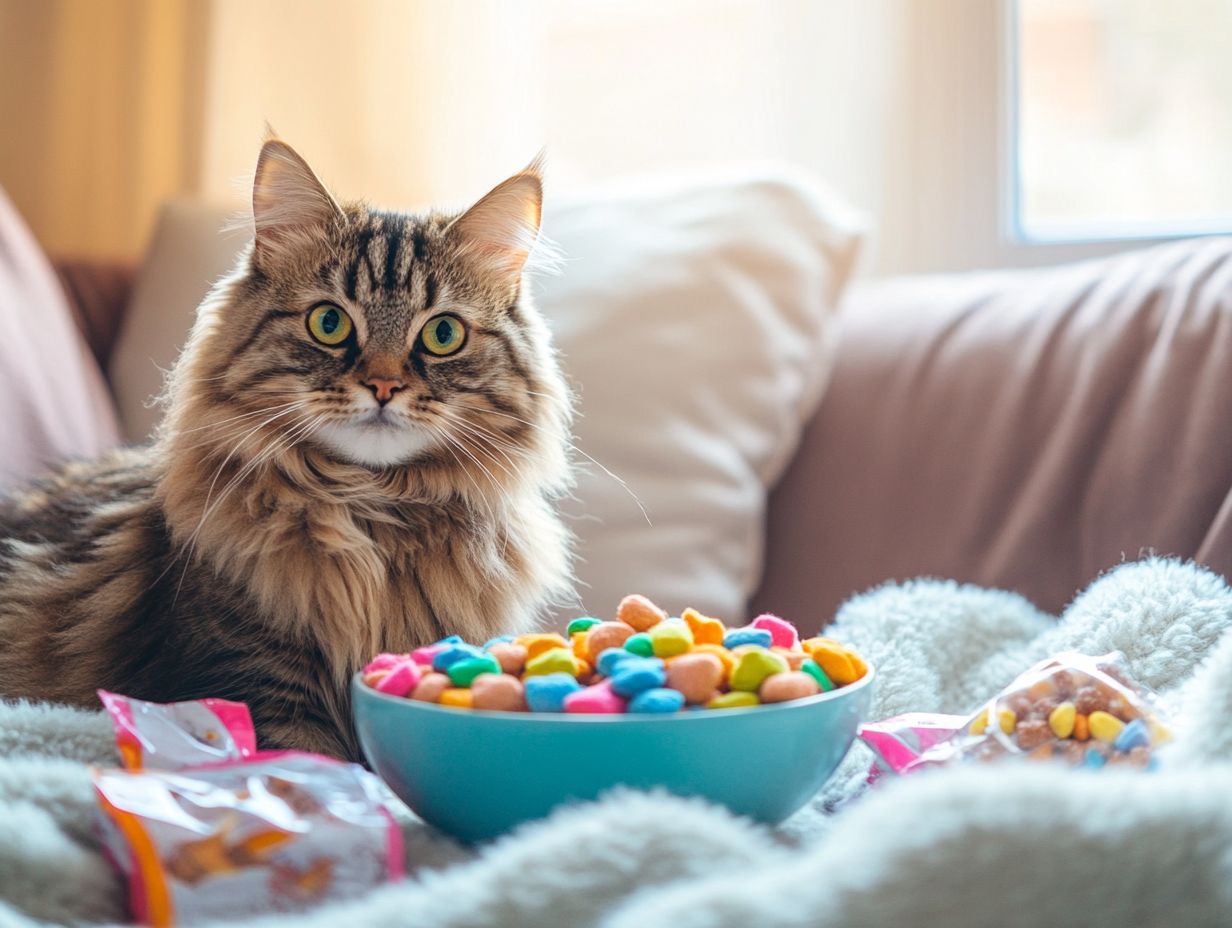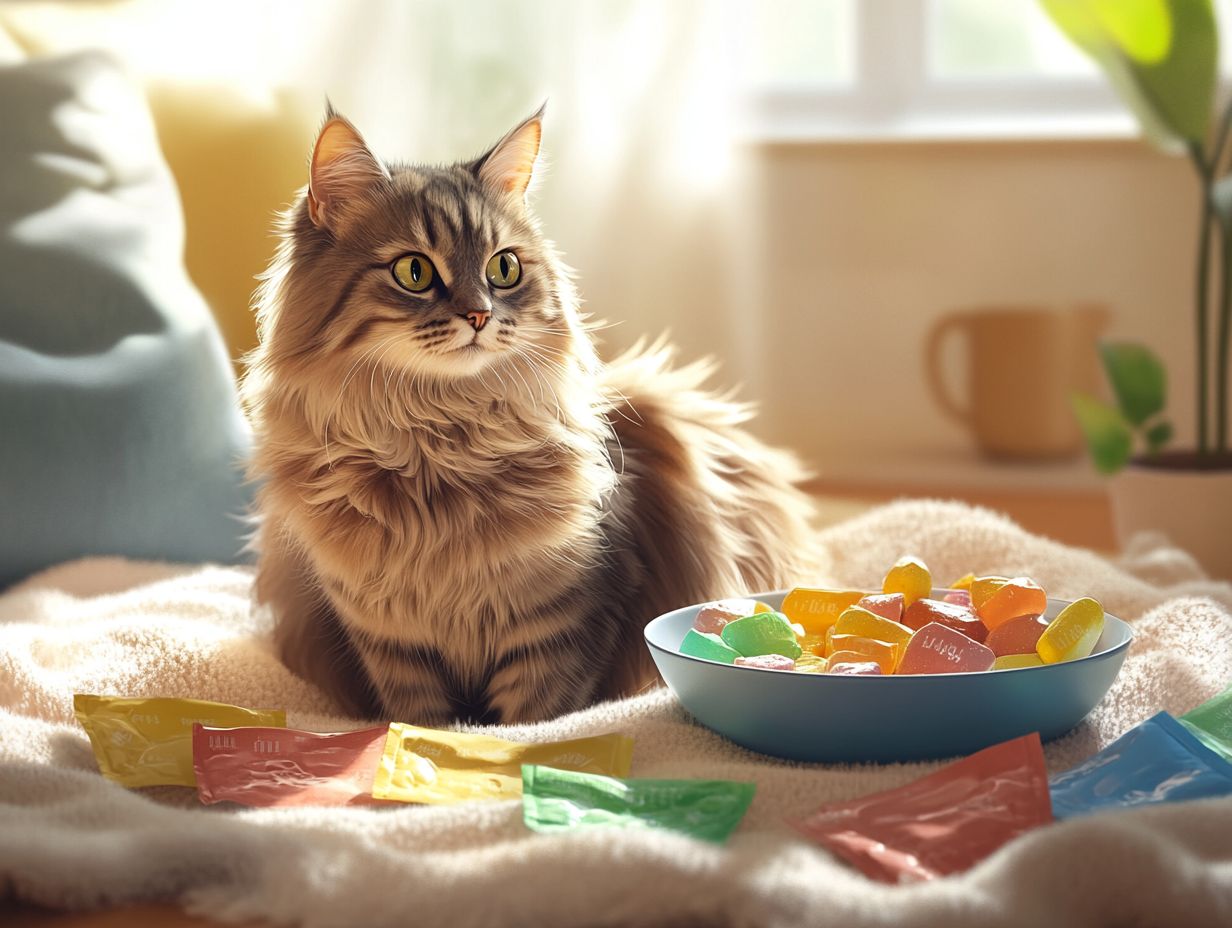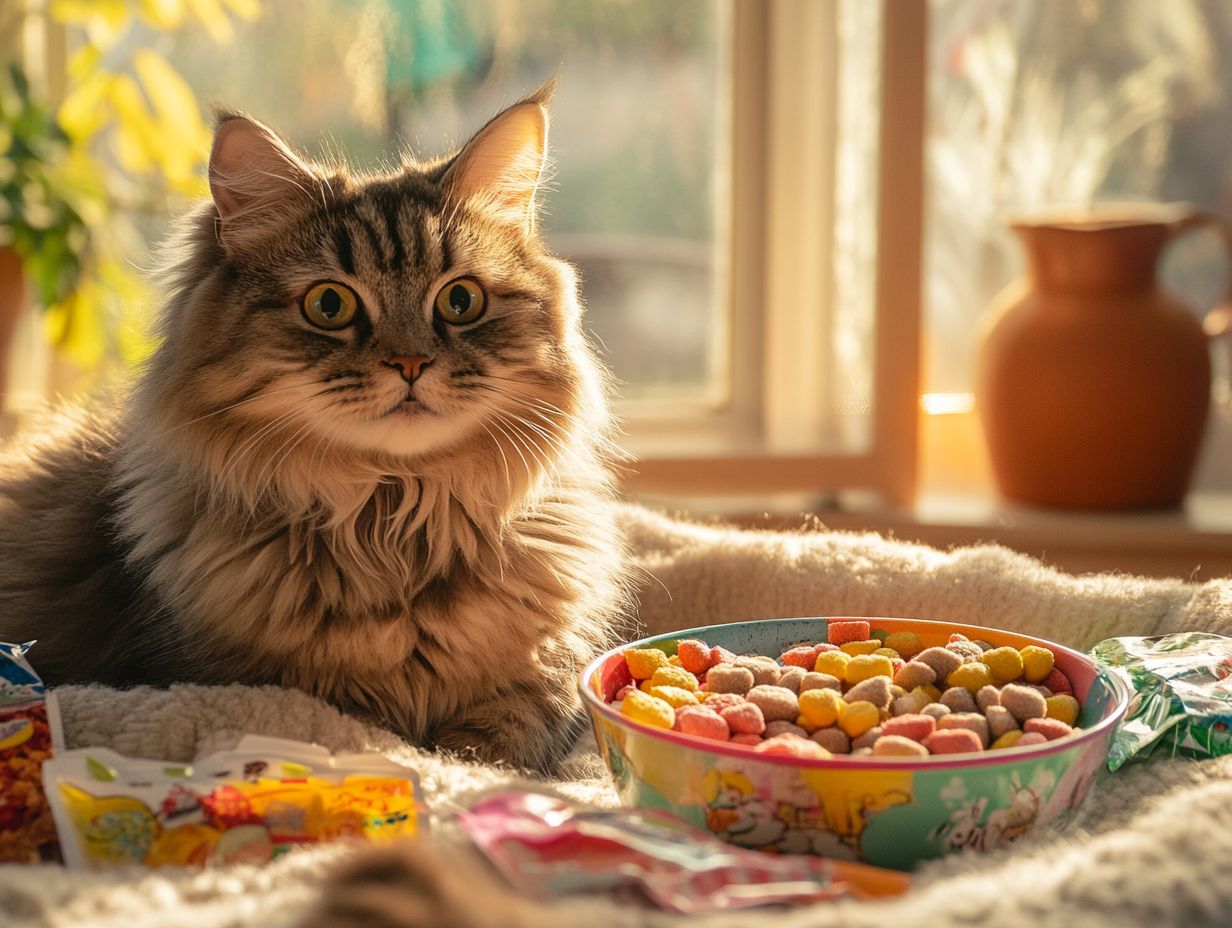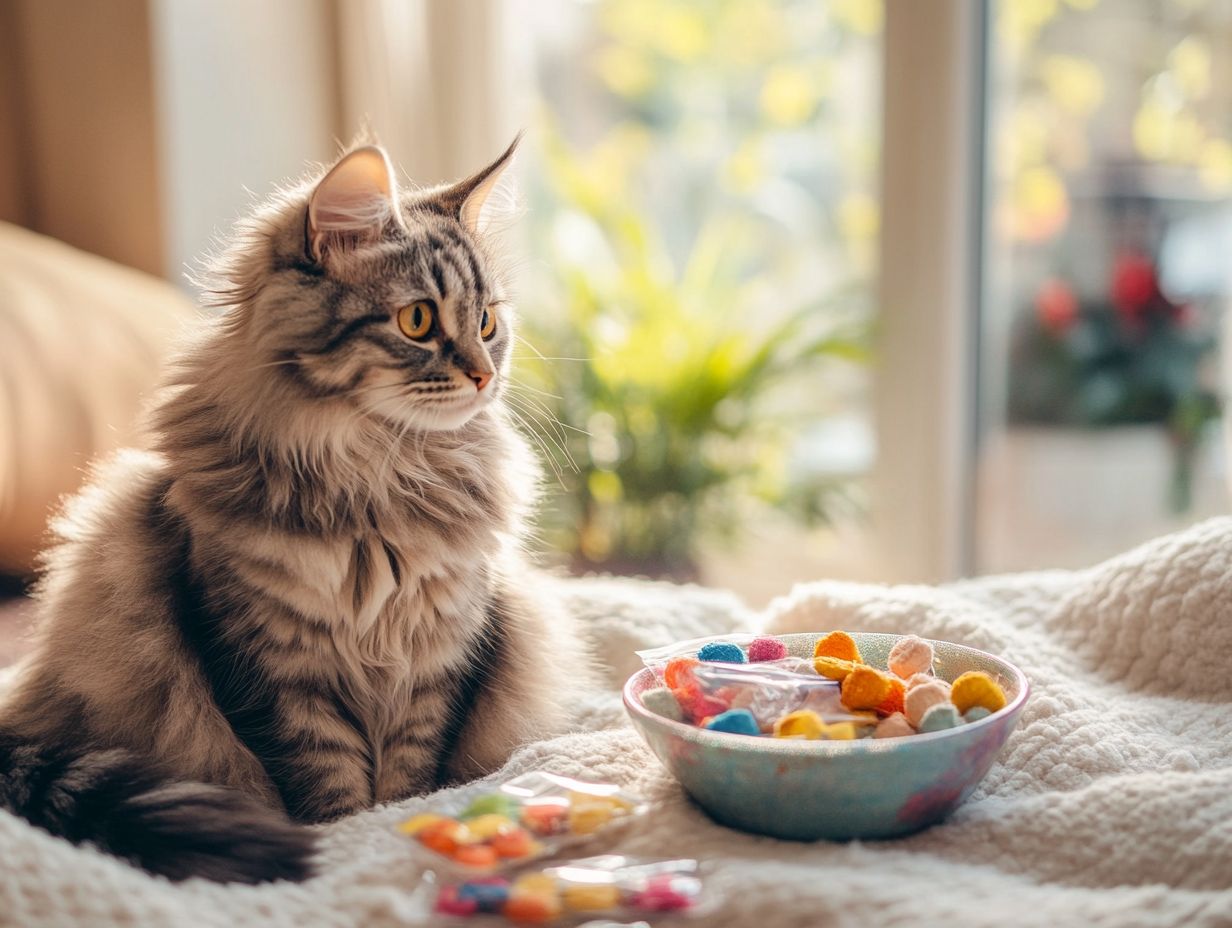Finding the perfect treats for your indoor cat can be a delightful challenge, especially when considering options such as people food alternatives and cat grass. Always consult with your veterinarian to ensure that any dietary changes suit your cat’s specific health conditions.
With many options available, it’s essential to choose treats that satisfy their taste buds and support their health, ensuring these options are both healthy and suitable for your feline friend. Cats, being obligate carnivores, thrive on animal-source proteins that meet their unique nutritional needs.
This guide explores the best indoor-friendly cat treats that keep your furry friend engaged and happy, offering insights from experts and tips on selecting the right treats and creative ways to serve them. Remember, treats can be a great way to show affection but should be provided in moderation to prevent obesity.
Your cat deserves the best—let’s ensure they get it with options vetted by veterinary nutritionists! Always monitor for any adverse reactions, especially with common allergens like fish or certain proteins.
Key Takeaways:

- Provide high-protein, freeze-dried chicken, turkey, or beef treats for a healthy and satisfying snack, ensuring they meet AAFCO standards.
- Choose treats with natural ingredients and added nutrients, like pureed vegetables such as pumpkin or carrots, to meet your cat’s dietary needs and avoid artificial colors and flavors.
- Get creative with how you give treats to your indoor cat by using puzzle feeders, hiding treats around the house, and creating a treat trail for added physical and mental stimulation.
What are the Best Indoor-Friendly Treats for Cats?
Indoor cats are often provided with the best indoor-friendly treats to maintain their health while also offering a pleasurable reward. Treats play a significant role in a cat’s diet, serving as a way to show affection and contributing dietary benefits that can help prevent weight issues and obesity—especially if they are low in calories and high in quality animal protein.
Experts like Marla J. McGeorge, DVM, recommend selecting indoor cat treats that meet AAFCO standards and include high-quality ingredients, such as premium proteins and vegetables, like spinach or peas, which promote your cat’s overall health. Be cautious about allergens and consult veterinary professionals if in doubt.
1. Freeze-Dried Chicken or Turkey
Freeze-dried chicken and turkey are both healthy and flavorful cat treats that are high in protein, satisfying your cat’s natural hunting instincts. These treats are especially suitable for indoor cats, who may not exercise as much as their outdoor counterparts, but should be balanced with their overall diet.
Along with appealing to their hunting instincts, these protein-rich snacks contribute to a balanced diet and support muscle health, both of which are crucial for a healthy lifestyle. Always ensure these treats are sourced from reputable manufacturers.
Unlike many commercially produced treats, freeze-dried options often come in low-calorie varieties, making them a great choice for cats that need to manage their weight.
By incorporating these nutritious snacks into their diet, cat owners can feel assured about their pets’ health, as they help reduce the risk of obesity from overfeeding and promote moderation in treat-giving. Consulting veterinary care professionals like Susan G. Wynn, DVM, can provide additional guidance on specific dietary needs.
2. Salmon or Tuna Treats
Salmon and tuna treats offer cats a rich source of omega-3 fatty acids, which provide numerous benefits, including improved coat appearance and joint health. These treats are also favored by many cats, making them a popular choice among cat owners. However, be mindful of the risk of allergies and monitor for any adverse reactions.
One of the primary advantages of omega-3 fatty acids for cats is their positive impact on cardiovascular health, helping to ensure that their hearts function properly. Additionally, salmon and tuna treats contribute to both the appearance and longevity of cats.
It is crucial to source these fish treats sustainably to protect ocean ecosystems while also prioritizing the health and nutritional needs of your cat. Cat caregivers should also be mindful of the caloric content of these treats and their potential impact on a cat’s metabolic rate, as excessive consumption can lead to obesity, a common issue that can result in various health complications.
For more information on fish-based cat treats, refer to this article by the University of Minnesota Extension Service.
3. Catnip Treats
Catnip treats for indoor cats offer an enjoyable taste and provide bursts of energy that often lead to affectionate moments between pets and their owners. This natural herb can stimulate playful behavior, making it an excellent way to engage cats in a fun and healthy manner. Be cautious with the quantity given, as too much catnip can lead to hyperactivity.
For cats with specific health conditions, such as kidney disease or diabetes, consult your veterinarian for suitable treat options that align with their dietary restrictions.
When storing treats, keep them in a cool, dry place and check for signs of spoilage, such as changes in odor or appearance, to ensure they remain safe for your pet.
Many cats exhibit playful behaviors such as rolling, leaping, and pouncing when exposed to catnip. These actions mimic natural hunting practices and promote increased physical activity. This is especially beneficial for cats that primarily stay indoors, as it helps combat boredom and reduces the risk of obesity.
However, catnip should be given in moderation—typically no more than once a week—to prevent overstimulation and to maintain its effectiveness over time. By incorporating this herb into their care in a balanced way, cat owners can ensure happier, more active cats while maintaining the right balance of nutrients in their diet. Options like fresh greens, including cat grass, can also be excellent additions.
4. Dental Treats
Dental treats for cats play a crucial role in maintaining their oral health, as they help reduce plaque and tartar formation while providing a satisfying chewing experience. Formulated to support dental health, these treats are both tasty and entertaining for felines. Veterinarians emphasize that proactive dental care is essential, as many common oral diseases can be easily prevented with the regular use of dental treats. Providing these treats promotes a cleaner mouth and offers a natural way to scrape away harmful bacteria.
Experts recommend choosing treats specifically designed for dental care and giving them in moderation—typically, no more than a few treats per week—to maintain a balanced diet. Early signs of dental issues, such as bad breath, difficulty eating, and bleeding or inflamed gums, can often be addressed quickly to ensure overall health is protected. Regular check-ups are important for catching these issues early, so it is essential for pet owners to be aware of their cats’ dental needs.
5. Homemade Treats

Homemade treats offer pet parents the chance to create healthy, organic food while maintaining strict control over ingredients to meet their pets’ specific dietary needs. Simple recipes that incorporate pureed vegetables like broccoli or green beans and proteins like chicken or fish, while avoiding toxic foods such as onions, garlic, and chocolate, allow you to pamper your feline friend safely.
This practice not only strengthens the bond between caregiver and pet but also promotes overall well-being by providing essential nutrients. Along with choosing fresh, organic ingredients, pet owners must be mindful of portion sizes to prevent overfeeding.
Reading food labels is crucial, as it helps caregivers identify potential allergens and avoid harmful preservatives. Nutrition plays a vital role in a cat’s health, and consulting a veterinarian for recommendations can be beneficial. Keep in mind that not all homemade treats provide complete nutrition; it is important to maintain a balanced diet to prevent nutritional deficiencies.
Easy homemade recipes can create balanced snacks that keep your kitty active and content, providing peace of mind for caring pet parents. Also, consider proper storage of homemade treats by keeping them in a cool, dry place to prevent spoilage and contamination.
How to Choose the Right Treat for Your Cat?
Choosing the right treats for a cat involves understanding their specific dietary needs, which can vary based on factors such as age, activity level, and any pre-existing health conditions.
It is important to read ingredient lists carefully, ensuring that the treats are not only enjoyable for the cat but also contribute to meeting its nutritional needs while helping to prevent obesity. Over-treating can contribute to weight gain, so moderation is key.
1. Consider Your Cat’s Dietary Needs
Understanding your cat’s dietary needs is essential for selecting the appropriate treats that will complement their regular diet and support their overall health. Factors to consider include their age, weight, activity level, and any pre-existing health conditions, such as liver disease or obesity, which can affect their eating behavior.
For kittens, they require a diet higher in protein and calories to support their growth. Senior cats may need lower calorie diets to prevent obesity but require key nutrients to support aging joints. Cats with conditions like diabetes or kidney disease may need specialized diets; consulting with a veterinary nutritionist can offer valuable guidance in addressing these factors.
Key nutrients, such as adequate protein and the right calorie density, are crucial for maintaining your cat’s health, ensuring that their energy levels remain optimal while preventing unnecessary weight gain.
2. Read the Ingredients List
Reading the ingredients list on treat packaging is essential for pet parents to ensure they provide their cats with nutritionally appropriate options instead of unhealthy fillers or toxic foods. Treats formulated to meet AAFCO standards should contain recognizable ingredients, with animal-source protein ideally listed at the top. This careful examination enables guardians to make informed choices that promote their feline friends’ overall health and well-being. Note that AAFCO approval does not necessarily mean the treat is suitable for all dietary needs.
It is crucial to watch for harmful additives, such as artificial preservatives, colorings, or excessive sugars, which can lead to health issues over time due to a lack of appropriate dietary management. Pet owners should also be vigilant about common toxic foods like garlic and onions, as these can be detrimental to a cat’s health.
To safeguard their pets, choosing treats that are AAFCO-approved ensures that the products meet high nutritional standards, providing better assurance that the treats are safe and beneficial.
3. Avoid Treats with Artificial Colors or Flavors
You should avoid feeding cats treats that contain artificial colors or flavors, as these chemicals can be harmful and may lead to obesity or digestive issues from poor dietary management. It’s important to consult with a veterinarian before introducing new treats, especially for cats with existing health conditions. Natural ingredients promote better health outcomes and enhance the happiness of cats.
Artificial additives can disrupt normal metabolism, resulting in a range of health complications, including weight gain and potential behavioral changes. Many pet owners are unaware that these unnecessary chemicals can alter a cat’s behavior, potentially causing increased hyperactivity or lethargy.
By opting for natural alternatives, pet owners not only protect their cats from these issues but also support better weight management and digestion. Treats made with whole, nutrient-rich ingredients strengthen the immune system and boost vitality, helping to ensure that cats enjoy long, happy, and healthy lives, free from the detrimental effects of artificial additives and other harmful elements often found in commercial pet food.
4. Look for Treats with Added Nutrients
Treats enriched with added nutrients can enhance your cat’s health by providing vitamins and minerals that may be lacking in their regular diet. These nutrients support immune function, digestion, and overall well-being. Consulting with a veterinary nutritionist can provide tailored advice to ensure your cat’s diet meets all their nutritional needs.
For instance, vitamin E acts as an antioxidant, while B vitamins contribute to energy metabolism and coat health. Additionally, minerals like taurine are vital for maintaining heart and eye health, as it is an essential amino acid for cats. Some treats are formulated with added nutrients to support specific health needs, enhancing your feline friend’s overall well-being.
When selecting treats, it is important to read labels carefully to identify those that contain these beneficial nutrients. Cat owners should seek out treats that clearly indicate the presence of these nutrients and specify whether they are available in amounts that can assist with particular health concerns. Consulting a veterinary expert can also provide insights on selecting the best treats for your cat’s specific dietary needs.
Consulting a veterinarian or a veterinary nutritionist can offer tailored advice on choosing treats that will effectively supplement your cat’s diet according to their specific nutritional needs. For instance, experts like Dr. Marla J. McGeorge and Dr. Susan G. Wynn can provide valuable information on optimal feline nutrition.
What are Some Fun Ways to Give Indoor-Friendly Treats to Your Cat?

You can encourage your indoor cat to play and exercise while enjoying their treats by actively engaging them during treat time. Distributing treats in a way that requires physical play or mental effort can provide both stimulation and exercise for your indoor cat. This helps prevent obesity and keeps your pet healthy and happy. It’s also important to monitor treat intake to maintain weight and health, especially in indoor cats.
Techniques such as using puzzle feeders, setting up interactive toss-and-find games, or hiding treats around the house are not only entertaining for cats but also enhance their environment and stimulate their natural foraging behavior. Using treats made of high-quality protein like chicken or beef can provide additional nutritional benefits.
Additionally, kittens and senior cats have unique dietary needs. Kittens require treats that support their rapid growth and development, whereas senior cats may benefit from treats formulated to support joint health and mobility. Always consider these factors when selecting treats for your feline friends.
1. Use Puzzle Toys
Puzzle toys are an effective method to provide cats with stimulating challenges while rewarding them with their favorite treats. Interactive feeders encourage problem-solving skills, keep indoor cats mentally engaged, reduce boredom, and promote healthy exercise, as supported by current veterinary research. Using treats that are low in calories and meet AAFCO standards can also help manage your cat’s weight more effectively and prevent obesity, which is a significant concern for indoor cats.
By enticing cats to paw, nudge, or roll the toy, pet owners can create a playful environment that mimics natural hunting behaviors. This interactive play not only sharpens a cat’s cognitive abilities but also helps maintain a healthy weight by encouraging movement and exploration. Additionally, incorporating treats made from organic, unseasoned ingredients that meet AAFCO standards can further promote your cat’s overall health.
Incorporating these toys into treat-giving routines can turn mealtime into an enjoyable game, with options like treat-dispensing balls or maze-style feeders. Such activities foster a stronger bond between pets and their owners while ensuring that felines receive both physical and mental enrichment, ultimately leading to happier and healthier furry companions. Treats that are formulated by AAFCO standards provide an additional level of assurance for pet parents concerned about nutrition. It’s important to be cautious of portion control when using treats to prevent overfeeding.
2. Hide Treats Around the House
Hiding snacks around the house turns mealtimes into a fun exercise for your cat, allowing them to tap into their natural hunting instincts. This activity encourages them to engage with their environment, making the search for food more complex and enjoyable while also stimulating their mental faculties. Be sure to choose treats that align with your cat’s dietary needs to prevent digestive issues, particularly in cases of obesity or diabetes.
Additionally, it promotes physical activity, which is crucial for preventing obesity. When snacks are hidden in places that require jumping or stretching, it provides a form of exercise that diversifies their play and encourages a variety of movements. This practice can also help mitigate weight problems that are common in indoor cats.
Moreover, hiding snacks fosters problem-solving skills, as cats learn to associate specific scents or locations with rewards. This practice mimics natural hunting behavior and provides both physical and mental stimulation.
3. Make a Treat Trail
A treat trail takes your cat on an adventurous journey through your home, stimulating their hunting instincts and rewarding them with treats along the way. This activity not only promotes a sense of adventure but also helps to reduce boredom. Using treats made of high-quality protein sources, such as turkey or fish, adds nutritional value to this fun activity and supports their dietary needs.
A treat trail is both enjoyable and essential for your cat’s mental stimulation. By placing treats in various locations, you encourage your cat to utilize their natural hunting abilities to sniff, pounce, and forage as they would in the wild. This activity fosters both physical movement and mental engagement as they follow the trail you’ve created. Additionally, incorporating vitamin-rich vegetables like carrots or spinach can provide health benefits, but they should not replace essential nutrients from animal proteins. Always consult a veterinarian for guidance.
Frequently changing the treat locations and using different scents can keep your cat engaged and motivated to explore further, ultimately enhancing their overall well-being. Choosing treats that are low in calories, free from artificial additives, and devoid of common allergens like wheat or dairy is also recommended to maintain a healthy diet.
4. Use Treat Dispensing Toys
Treat-dispensing toys are excellent for promoting interactive play and keeping indoor cats physically active while they enjoy their favorite snacks. These toys encourage cats to work for their treats, offering a rewarding challenge during snack time. Treats made from fresh ingredients like pumpkin or broccoli can offer added nutritional benefits.
By tapping into a cat’s natural hunting instincts, these toys provide essential exercise and mental stimulation, making the experience both fun and healthy. When selecting the right toy, it’s important to consider the cat’s individual play style and preferences; some cats may enjoy more challenging designs that dispense treats only after some effort, while others may prefer simpler models that release treats quickly. Always choose treats that are vet-approved to avoid issues related to allergies or toxic foods.
It is also crucial to emphasize the importance of regular veterinary check-ups to tailor treat options and feeding practices to the individual health needs of each cat, especially for those with existing health conditions. Additionally, pet owners should consult their veterinarian before introducing new treats or feeding methods, particularly if their cat has special dietary needs or health concerns.
It is also essential to choose durable materials that can withstand vigorous play and are easy to fill. With the right selection, these interactive feeding tools can significantly enhance a cat’s daily routine by promoting better exercise and feeding habits while providing hours of entertainment. For added variety, consider treats that are specifically formulated for cats, and consult with a veterinarian before introducing any new foods.
Frequently Asked Questions
What are the top indoor-friendly treats for happy, healthy cats?

Some of the top treats for indoor cats include freeze-dried meat snacks, catnip treats, and dental chews. Additionally, treats made from fresh greens like cat grass can provide unique health benefits, but it’s important to ensure they are safe and appropriate for your cat.
Are there any treats specifically made for indoor cats?
Yes, there are many treats on the market that are specifically formulated for indoor cats. These treats are often lower in calories and help prevent weight gain in less active indoor cats. Look for treats made with natural ingredients and free from artificial additives for optimal nutrition.
Can indoor cats have treats as part of their daily diet?
It is important to limit the amount of treats given to indoor cats to prevent obesity and other health issues. Treats should only make up 10% of a cat’s daily calorie intake, based on their overall dietary needs as obligate carnivores. Moderation is key, and consulting with veterinary experts can help ensure your cat’s treats are part of a balanced diet.
What are the benefits of giving indoor cats treats?
Treats can be a great way to bond with your indoor cat and provide mental stimulation. They can also be used for training and as a form of reward for good behavior. Additionally, using treats to pamper your cat shows affection and strengthens the pet-parent relationship. However, it’s crucial to be aware of potential risks, such as obesity or harmful ingredients, and to ensure treats do not compromise a balanced diet.
Are there any treats that can help with dental health for indoor cats?
Yes, there are dental treats specifically designed for cats that can help reduce plaque and tartar buildup. These treats also promote healthy gums and freshen breath. Always check for AAFCO approval to ensure the treats meet essential nutritional standards.
What are some alternative options to traditional treats for indoor cats?
Some alternative options include using small portions of your cat’s regular food as treats, providing interactive toys for mental stimulation, and offering fresh vegetables like carrots or green beans as low-calorie treats. Homemade treats should be discussed with a veterinarian to avoid nutritional imbalances.
Should I consider supplements for my cat’s diet?
Consulting with a veterinarian about the necessity and safety of supplements can enhance your cat’s diet. Some supplements might be beneficial, especially for cats with special health conditions or dietary needs, but always ensure they are appropriate for your cat’s life stage.
How should I store and handle cat treats?
It’s important to store treats properly to maintain their freshness and safety. Keep treats in a cool, dry place and check for spoilage—look for changes in smell, color, or texture.
What common harmful practices should I avoid?
Be cautious about feeding inappropriate human foods that can lead to health issues, such as onions, garlic, or chocolate. Always prioritize your cat’s health by consulting with a veterinarian before introducing any new foods.
Should I consider ethical and sustainability concerns when choosing treats?
When selecting treats, sourcing from ethical and sustainable sources is important while ensuring your cat’s health remains the priority.